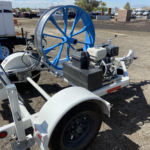Asphalt is a vital component of any property’s infrastructure, serving as the foundation for parking lots, driveways, and walkways. However, maintaining asphalt surfaces in desert climates poses unique challenges, especially after the intense heat of summer. Property managers in regions such as Southern Nevada and Las Vegas understand the toll that months of relentless sun and high temperatures can take on asphalt surfaces.
In desert environments, where temperatures often soar well over 100 degrees Fahrenheit, the summer season can cause significant stress on asphalt. If left unchecked, this damage can lead to costly repairs, safety hazards, and ultimately, a shorter lifespan for the asphalt. Conducting a thorough inspection of asphalt surfaces after the summer months is essential for mitigating damage and ensuring the longevity of the pavement.
How Summer Heat Impacts Asphalt in Desert Climates
Desert climates subject asphalt to extreme temperature fluctuations, especially during the summer. The intense heat can cause several issues:
- Thermal Expansion and Contraction: Asphalt expands in high temperatures and contracts when temperatures cool down at night. This constant cycle of expansion and contraction can weaken the surface, leading to cracks and potholes over time. In desert climates, where the temperature shift between day and night can be significant, this effect is particularly pronounced.
- Oxidation: The sun’s ultraviolet (UV) rays contribute to the oxidation of asphalt, which causes the surface to become brittle and lose its flexibility. As asphalt oxidizes, it turns gray, indicating a breakdown of the binding agents that hold the aggregate together. This makes the surface more prone to cracking and raveling, where pieces of the pavement start to come loose.
- Surface Softening and Rutting: High temperatures can soften asphalt, especially if it wasn’t properly installed or lacks adequate compaction. This can result in rutting, where depressions form on the surface, particularly in areas with heavy vehicle traffic. Softened asphalt is also more susceptible to damage from objects, such as the wheels of a vehicle turning on the surface.
- Moisture Depletion: Desert environments are characterized by low humidity and scarce rainfall, which can cause asphalt to dry out. Without moisture, asphalt loses some of its flexibility, leading to cracking and other forms of deterioration.
Signs of Asphalt Damage After Summer Heat
After a long, hot summer, property managers should carefully inspect asphalt surfaces for signs of damage. Some common issues to look for include:
- Cracks: One of the most common forms of damage caused by summer heat is cracking. These can range from small, hairline cracks to larger, more pronounced cracks. Cracking can occur from thermal expansion, oxidation, or heavy vehicle loads on weakened pavement. If left untreated, cracks can allow water to seep in, which exacerbates the damage during cooler months.
- Potholes: Potholes form when cracks in asphalt allow water to seep into the sublayer of the pavement, weakening its structure. Leaks or breaks in irrigation systems can accelerate this process by introducing excess moisture to areas not typically exposed to rainfall. Over time, the water undermines the pavement, causing sections of asphalt to break apart. In desert climates, while rainfall is scarce, irrigation systems become a primary source of water damage. Combined with the stress of extreme summer heat, even minor cracks can quickly expand into larger potholes if not addressed.
- Raveling: This occurs when the asphalt surface begins to deteriorate, and small pieces of aggregate break loose. Raveling often happens as a result of oxidation, and it can lead to a rough, uneven surface. If not addressed, raveling can turn into larger structural issues.
- Fading and Discoloration: Asphalt surfaces that have undergone extensive UV exposure will show signs of fading, turning from a rich black to a dull gray. While this is primarily an aesthetic issue, it’s also an indicator that the asphalt’s protective oils have been depleted, making it more vulnerable to cracking and damage.
- Surface Distortion: Softened asphalt may show signs of rutting or indentations, especially in areas with frequent vehicle traffic. Surface distortions create uneven driving conditions and can contribute to further damage if not addressed promptly.
Tips for Assessing Asphalt in the Fall
Conducting a detailed inspection in the fall allows property managers to address any summer-related damage before the winter months set in. Here’s how to effectively assess asphalt surfaces:
- Visual Inspection: Begin by walking the entire asphalt surface, paying close attention to areas with visible cracks, potholes, or surface raveling. Take note of any sections that appear faded, discolored, or uneven. Use this opportunity to identify areas that may need immediate attention, such as major cracks or potholes.
- Check for Drainage Issues: Even in desert climates, it’s important to ensure proper drainage. Clogged drains, standing water, irrigation leaks or improperly sloped areas can lead to water pooling on the asphalt, which accelerates deterioration. Inspect curbs, drains, and surrounding landscape for any signs of drainage or leak problems.
- Test for Flexibility: Using a screwdriver or other tool, test the flexibility of the asphalt. If the surface is hard and brittle, it’s a sign of oxidation and increased vulnerability to cracking. Softened areas may indicate improper installation or compaction issues, which can lead to rutting and other damage.
- Evaluate Traffic Patterns: Areas with heavy vehicle traffic or frequent turning, such as loading zones or entrances, are more prone to damage. Assess these high-traffic areas for surface wear, rutting, and cracks.
- Consult a Professional: If the asphalt shows signs of significant damage, it’s wise to consult with a professional asphalt contractor. They can provide a more detailed assessment and recommend the best course of action, whether it’s crack sealing, patching, or resurfacing.
Fall Maintenance to Prolong Asphalt Lifespan
After assessing the condition of your asphalt, fall is the perfect time to perform maintenance tasks that will help preserve its integrity through the winter months and beyond:
- Crack Sealing: Sealing cracks in the fall prevents water from seeping into the pavement during the cooler months. In desert climates, where rainfall is sparse but can be intense, sealing cracks is essential for preventing further deterioration.
- Sealcoating: Applying a fresh layer of seal coat helps protect the asphalt from UV rays and restores its dark, rich appearance. Sealcoating also adds a layer of protection against oil, gas, and other vehicle fluids that can degrade the surface.
- Pothole Repair: Any potholes or large cracks should be filled and repaired before winter. Left untreated, these can worsen during colder weather, leading to more extensive repairs down the road.
For property managers in desert climates, taking a proactive stance on asphalt maintenance after the intense summer heat is essential. Regularly inspecting your asphalt for cracks, potholes, and other signs of wear—and addressing these issues in the fall—will extend the life of your pavement and prevent costly repairs down the line. By staying ahead of potential problems, you can maintain the safety, functionality, and visual appeal of your property. To ensure top-quality results and professional service, contact Terra Contracting to request a bid for your asphalt maintenance needs. Let our experts help you protect your investment and keep your property looking its best.


